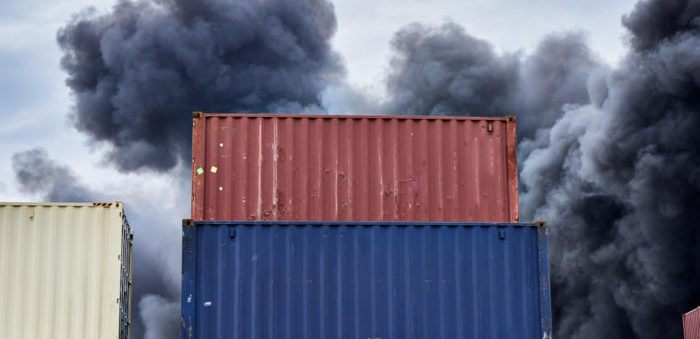During the last SAFETY4SEA Singapore Forum, Ashok Srinivasan, Manager in Maritime Technology/ Regulation Department, BIMCO, gave an insight on container ship fires. Such incidents have been on the spotlight recently, and Mr. Srinivasan explored the possible causes, as well as solutions to tackle the problem.
Container ships have seen a huge growth in the last 50 years in terms of size and cargo capacity and now are one of the biggest cargo movers in the water.
Some of the reasons for this growth are:
- Increased economy;
- Increase in competition;
- Increased efficiency using economies of scale;
- Development of technology.
While there has been a significant improvement in the cargo capacity, the same cannot be said when it comes to fire safety aspects.
Most container ship cargo holds are equipped with a smoke extraction system. The smoke is extracted from the top of the hold space and it travels through thin pipes up to the accommodation or sometimes up to the bridge, where the smoke detector is installed. Once the smoke reaches the sensor, it is analyzed, and if required, fire alarm is activated.
On the other hand, container ship cargo holds are also equipped with strong ventilation systems that exchanges the air in the cargo hold up to six air exchanges per hour. This means, when there is a small fire in the middle and bottom of the cargo hold, it may get sucked out of the cargo hold through the ventilation systems before it reaches the smoke extraction system. This delays the detection of fire in a cargo hold in its initial stages.
The three most important aspects of a fire are:
2. Fuel;
3. Heat.
We know this as a fire triangle and our firefighting courses teach us to remove one of these components of the fire triangle to extinguish the fire. Most container ships have carbon di oxide (CO2) as fixed firefighting media. This normally cuts off the oxygen supply to the fire thereby smothering it. However, we also carry cargo that disintegrates and makes its own oxygen. These are categorized as IMDG class 5 – oxidizing agents.
An example of an oxidizer – Calcium hypochlorite
Calcium hypochlorite is a seemingly harmless cargo, used as a chemical to clean swimming pools, water cleaners and big water pools. The cargo itself is non-flammable, but it is an oxidizer, which means when it disintegrates, it produces oxygen, and other gases, which can inflame the cargoes around it.
All that is needed to disintegrate this cargo is to increase its temperature. So, in ambient temperatures, it’s quite stable, but if the temperature is increased, it disintegrates, producing oxygen, toxic gases and heat. As the temperature increases, it decomposes faster, producing more heat. This is enough to bring the cargoes around it, to their ignition temperature. This is a chemical reaction, at the start of which, there is no fire, but the cargo produces enough heat to start a fire and the presence of oxygen negates the effect of our carbon di oxide (CO2) firefighting systems.
The fire as we know from a fire triangle is mostly a physical reaction. However, fire can also occur as a result of a chemical reaction.
There are two main kinds of chemical reactions:
- Endothermic: A chemical reaction that absorbs overall heat, leaving a cooling environment around it;
- Exothermic: A chemical reaction that releases heat as a result of the reaction.
An example of exothermic chemical reaction – Lithium (Li) ion batteries fire
We may notice from our demand of batteries that they should be smaller, lighter and yet pack more power. This cannot be achieved in a lead acid battery. However, lithium batteries can be small and light and still store a lot of energy. This also means that a small load of cargo, which is seemingly light and small in size, actually packs a lot of energy in it. During a fire, that energy is released in the form of heat and other toxic gases.
The chemical reaction that produces such heat and fire, can start when these batteries are stressed enough. That stress can be in the form of a thermal or mechanical or electrical stress. Thermal stress can happen when the temperature of cargo is increased. This happens when the ship is sailing in hotter weather conditions, or when the cargo is stored next to other hot objects, such as engine room, bunker tank, or other containers that produces heat (reefer container). A mechanical stress can happen as a result of other cargo falling over it or other mechanical damage. This can also happen during an already burning fire when another container falls on top of this container/cargo.
[smlsubform prepend=”GET THE SAFETY4SEA IN YOUR INBOX!” showname=false emailtxt=”” emailholder=”Enter your email address” showsubmit=true submittxt=”Submit” jsthanks=false thankyou=”Thank you for subscribing to our mailing list”]
Electrical stress happens due to overcharging, but this does not normally happen during a voyage on container ships.
When a charged Li-ion battery is burnt, it releases CO2 and a lot of carbon monoxide (CO) and hydrogen (H2). The carbon monoxide is very toxic and may explain the reason for toxic fumes during these fires. Hydrogen produces a lot of heat. On the other hand, if a Li-ion battery without charge is burnt, it mainly releases CO2.
What do we need to do?
We need to study our fire protection, fire detection and firefighting systems.
Some good examples exist on tankers and gas carriers.
A water spray system that produces a water curtain is a standard feature on gas tankers. It is located in front of the accommodation. If there is a fire, the accommodation at least is safe. Maersk Honam is an example where this could have been effective in reducing the damage to accommodation block.
Another standard feature of a gas tanker is to have water spray systems strategically located in the cargo area to tackle a fire at its source and reduce it from spreading to other areas.
Fixed fire monitors, as opposed to portable ones can be much more powerful and more effective in tackling a fire. This is a standard feature of oil and gas tankers. Some of these do not need human intervention thereby reducing the risk to human lives during a firefight.
In addition, for the carriage of liquid cargoes, tank containers are used that has inbuilt safety features such as relief valves to ensure that there is no explosion, spill tray to contain a cargo spill. For perishable cargoes, reefer containers are used. These are more expensive options but ensures that the cargo is transported safely.
However, when it comes to dangerous goods, they are carried in ordinary containers. Perhaps, it is time to look into designing containers that have inbuilt fire sensors such as flame, smoke, heat detectors, or even an inbuilt firefighting system that activates inside a container in case of a fire.
Perhaps it is time to look into innovative solutions for our existing problems.
Above text is an edited version of Mr. Srinivasan’s presentation during the 2019 SAFETY4SEA Singapore Forum.
You can view his video presentation bellow
The views presented hereabove are only those of the author and not necessarily those of SAFETY4SEA and are for information sharing and discussion purposes only.
Ashok Srinivasan, Manager in Maritime Technology/ Regulation Department, BIMCO
 Ashok is Manager, Maritime Technology and Regulation at BIMCO and is responsible for coordinating BIMCO’s initiatives on a variety of technical, operational and regulation related matters. He represents BIMCO at international organisations such as International Maritime Organization(IMO), International Association of Classification Societies(IACS) on aforementioned matters.
Ashok is Manager, Maritime Technology and Regulation at BIMCO and is responsible for coordinating BIMCO’s initiatives on a variety of technical, operational and regulation related matters. He represents BIMCO at international organisations such as International Maritime Organization(IMO), International Association of Classification Societies(IACS) on aforementioned matters.
He is educated as a master mariner, dynamic positioning officer, and marine lead auditor. He also holds an MBA (Master of Business Administration) from Copenhagen Business School. He is an experienced seafarer with 18 years of experience in the maritime sector. He started his career with A.P.Moller Maersk and has sailed on a variety of ships including containers, car carriers, oil tankers (crude and product), gas tankers (LPG and LNG) in the maritime shipping (13 years) and platform supply vessels & cable layers in the offshore sector (3years). Ashok has also been a visiting faculty at the marine colleges in India, where he taught navigation, safety and cargo related courses to budding seafarers.
He is certified as a lead auditor and integrated marine auditor by LRQA (Lloyds register quality assurance). He has conducted quality, safety and security audits on several ship types and helped prepare ships for external class audits (ISM, ISPS and MLC audits), and industry vetting inspections such as OCIMF-SIRE, CDI inspections.




























































